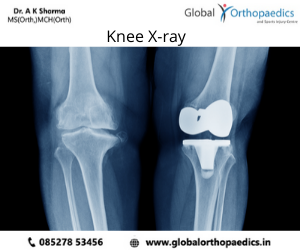Overview
Knee replacement or knee arthroplasty helps to recover from knee pain and restore function in severely diseased knee joints.
Knee replacement procedure involves cutting away the damaged bone and cartilage from the thighbone, shinbone, and kneecap and gets replaced with an artificial joint.
After examining the knee’s range of motion, stability, and strength, an orthopaedic surgeon will suggest you, whether it is required or not. With the help of an X-ray, an orthopaedic surgeon can determine the extent of the damage.

Why knee replacement?
People who have a knee problem and osteoarthritis face difficulties in walking, climbing stairs, and getting in and out of chairs. A knee replacement surgery helps them to get relieved from severe pain.
Types of knee replacement:
There are different types of knee replacements. Options include:
- Total knee replacement, where the whole knee is replaced.
- Partial knee replacement, where the affected part of the knee gets replaced
- Bilateral knee replacement: in this, both knees get replaced at the same time.
Preparation for knee replacement surgery:
A few weeks ago, the surgeon will take you through preoperative evaluation.
They can ask you about:
- Your overall health
- Medical history
- Medications and supplements you use
Knee replacement procedure:
Most of the knee replacement surgery get performed under a combination of general anesthesia, peripheral nerve blocks, and spinal (epidural) anesthesia. An orthopaedic surgeon also gives at least one dose of antibiotics to reduce the risk of infection.
During the surgery, the surgeon removes bone and diseased cartilage from where the thigh bone (femur) and shin bone (tibia) meet at the knee joint and replace the surface with a metal implant. A piece of special plastic used to replace the backside of the kneecap and get placed in between the two metal parts. It gives joints a smooth move so that they can flex and bends more freely and painlessly.
Risks of knee replacement surgery:
- Infection
- Blood clots
- Heart attack
- Stroke
- Nerve damage
Sign of infection:
Contact your orthopaedic surgeon immediately if you feel:
- High fever greater than 100 F (37.8 C)
- Drainage from the surgical site
- Tenderness, swelling and immense pain in the knee
Depending upon your infection, an orthopedic surgeon can give antibiotic or can suggest for a surgery to remove the artificial part, to prevent infection.
Cost of knee replacement:
The price can vary, depending upon your health and the procedure.
Along with the cost of the procedure, you should also consider additional costs for:
- Hospital stay
- Physical therapy in the hospital
- Therapy during recovery at home
- Follow-up appointments and care
- transportation costs
Exercise:
Exercise plays a key role in preventing any knee damage.

Your orthopaedic surgeon can suggest you for a short walk, yoga and strengthening exercise for mobility.
It is important to follow instructions carefully to recover and return to your normal daily activities as quickly as possible.


